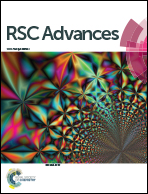An unprecedented approach to the Gabriel amine synthesis utilizing tosylhydrazones as alkylating agents†
Abstract
A new and one-pot version of the Gabriel phthalimide amine synthesis utilizing carbonyl compounds as alkylating agents via their tosylhydrazone surrogates is disclosed. The alkylation involves copper catalysed carbene insertion into the N–H bond of phthalimide. Basically, the protocol also offers a powerful tool for deoxygenative hydroamination of carbonyl compounds.


 Please wait while we load your content...
Please wait while we load your content...